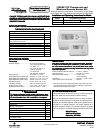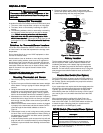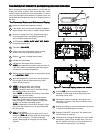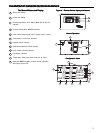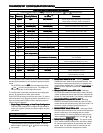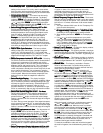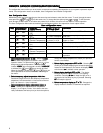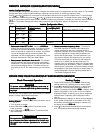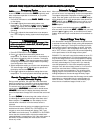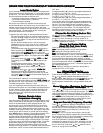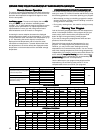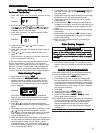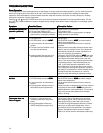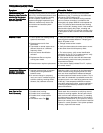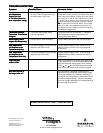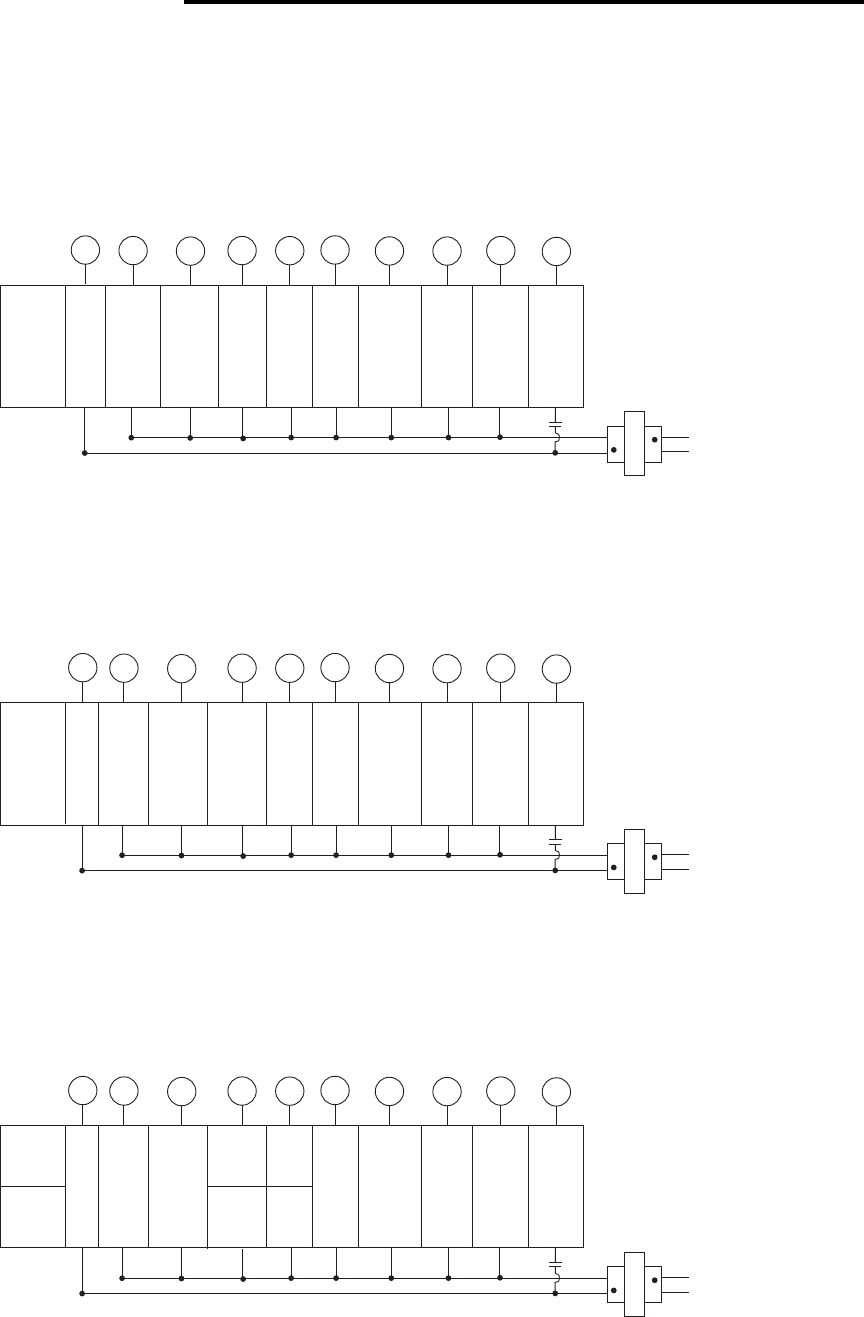
3
Heat Pump 1
(HP1)
Single
Compressor
Heat Pump
24 Volt
(Hot)
Blower/
Circulator
Fan Energized
on Call for
Heat/Cool
or Fan,
Note: Set
Elect/Gas
switch for
Emergency
Mode Heat Type
24 Volt
(Common)
Optional
Connection
System
*C
CLASS II
TRANSFORMER
HOT
24VAC
NEUTRAL
120VAC
Fault
Indicator
for Heat
Pump
Systems
with
Malfunction
Switch
L
R
E/W1
Y2
G
Emergency
Mode
1st Stage
Heat Mode-
1st Stage
Cool Mode-
1st Stage
(Compressor 1)
Y1
W2
Energized
in Cool
Mode
(Change-
over Valve)
O
Energized
in Heat, Off,
Emergency
Mode
(Change-
over Valve)
B
Heat Mode-
2nd Stage
Cool Mode-
2nd Stage
(Compressor 2)
Heat Pump 2
(HP2)
Two
Compressor
or Two Speed
Compressor
No Output
Heat
Mode
2nd Stage.
Emergency
Mode 2nd
Stage
Heat
Mode
3rd Stage.
Emergency
Mode 2nd
Stage
Multi-Stage
(MS2)
24 Volt
(Hot)
Blower/
Circulator
Fan Energized
on Call for
Cool or Fan,
Energized on
Call for Heat if
Elect/Gas
Switch Set to
Electric
24 Volt
(Common)
Optional
Connection
System
*C
CLASS II
TRANSFORMER
HOT
24VAC
NEUTRAL
120VAC
Fault
Indicator
for Heat
Pump
Systems
with
Malfunction
Switch
L
R
E/W1
Y2
G
Heat
Mode
1st Stage
Cool Mode
1st Stage
(Compressor 1)
Y1
Heat
Mode
2nd Stage
W2
Energized
in Cool
Mode
(Change-
over Valve
or Damper)
O
Energized
in Heat, Off
Mode
(Change-
over Valve
or Damper)
B
Cool Mode
2nd Stage
(Compressor 2)
Single Stage
(SS1)
24 Volt
(Hot)
Blower/
Circulator
Fan Energized
on Call for
Cool or Fan,
Energized on
Call for Heat if
Elect/Gas
Switch Set to
Electric
No Output
24 Volt
(Common)
Optional
Connection
System
*C
CLASS II
TRANSFORMER
HOT
24VAC
NEUTRAL
120VAC
Fault
Indicator
for Heat
Pump
Systems
with
Malfunction
Switch
L
R
E/W1
Y2
G
Heat
Mode
1st Stage
(Heater)
Cool Mode
1st Stage
(Compressor)
Y1
No Output
W2
Energized
in Cool
Mode
(Change-
over Valve
or Damper)
O
Energized
in Heat, Off
Mode
(Change-
over Valve
or Damper)
B
WIRING CONNECTIONSWIRING CONNECTIONS
WIRING CONNECTIONSWIRING CONNECTIONS
WIRING CONNECTIONS
Typical wiring diagrams are provided below for the following systems:
Single Stage Heat/Cool systems
Multi-Stage Heat/Cool systems (No Heat Pump)
Heat Pump system, one compressor or one speed compressor with Aux. Heat
Heat Pump systems, two compressors or two speed compressor with Aux. Heat
Refer to the equipment manufacturers instructions for specific wiring information. After completing the connections configure
the thermostat in the Installer Configuration Menu to match your system type.
Figure 4 – Single Stage (No Heat Pump) Terminal OutputsFigure 4 – Single Stage (No Heat Pump) Terminal Outputs
Figure 4 – Single Stage (No Heat Pump) Terminal OutputsFigure 4 – Single Stage (No Heat Pump) Terminal Outputs
Figure 4 – Single Stage (No Heat Pump) Terminal Outputs
**
**
*
The RC/PS switch shown in Figure 1 configures the thermostat for Hardwire or Power Stealing.The RC/PS switch shown in Figure 1 configures the thermostat for Hardwire or Power Stealing.
The RC/PS switch shown in Figure 1 configures the thermostat for Hardwire or Power Stealing.The RC/PS switch shown in Figure 1 configures the thermostat for Hardwire or Power Stealing.
The RC/PS switch shown in Figure 1 configures the thermostat for Hardwire or Power Stealing.
The factory setting is RC (Hardwire) and requires a Common connection from the system transformer to the "C" terminal on
the thermostat. If no common wire is available for the thermostat "C" terminal, move the RC/PS switch to PS (Power Steal-
ing).
NOTENOTE
NOTENOTE
NOTE: If set to PS (Power Stealing), the thermostat "C" terminal
must notmust not
must notmust not
must not
have a wire connected.
Figure 5 – Multi-Stage (No Heat Pump) Terminal OutputsFigure 5 – Multi-Stage (No Heat Pump) Terminal Outputs
Figure 5 – Multi-Stage (No Heat Pump) Terminal OutputsFigure 5 – Multi-Stage (No Heat Pump) Terminal Outputs
Figure 5 – Multi-Stage (No Heat Pump) Terminal Outputs
**
**
*
The RC/PS switch shown in Figure 1 configures the thermostat for Hardwire or Power Stealing.The RC/PS switch shown in Figure 1 configures the thermostat for Hardwire or Power Stealing.
The RC/PS switch shown in Figure 1 configures the thermostat for Hardwire or Power Stealing.The RC/PS switch shown in Figure 1 configures the thermostat for Hardwire or Power Stealing.
The RC/PS switch shown in Figure 1 configures the thermostat for Hardwire or Power Stealing.
The factory setting is RC (Hardwire) and requires a Common connection from the system transformer to the "C" terminal on
the thermostat. If no common wire is available for the thermostat "C" terminal, move the RC/PS switch to PS (Power Steal-
ing).
NOTENOTE
NOTENOTE
NOTE: If set to PS (Power Stealing), the thermostat "C" terminal
must notmust not
must notmust not
must not
have a wire connected.
Figure 6 – Heat Pump Terminal OutputsFigure 6 – Heat Pump Terminal Outputs
Figure 6 – Heat Pump Terminal OutputsFigure 6 – Heat Pump Terminal Outputs
Figure 6 – Heat Pump Terminal Outputs
**
**
*
The RC/PS switch shown in Figure 1 configures the thermostat for Hardwire or Power Stealing.The RC/PS switch shown in Figure 1 configures the thermostat for Hardwire or Power Stealing.
The RC/PS switch shown in Figure 1 configures the thermostat for Hardwire or Power Stealing.The RC/PS switch shown in Figure 1 configures the thermostat for Hardwire or Power Stealing.
The RC/PS switch shown in Figure 1 configures the thermostat for Hardwire or Power Stealing.
The factory setting is RC (Hardwire) and requires a Common connection from the system transformer to the "C" terminal on
the thermostat. If no common wire is available for the thermostat "C" terminal, move the RC/PS switch to PS (Power Steal-
ing).
NOTENOTE
NOTENOTE
NOTE: If set to PS (Power Stealing), the thermostat "C" terminal
must notmust not
must notmust not
must not
have a wire connected.



